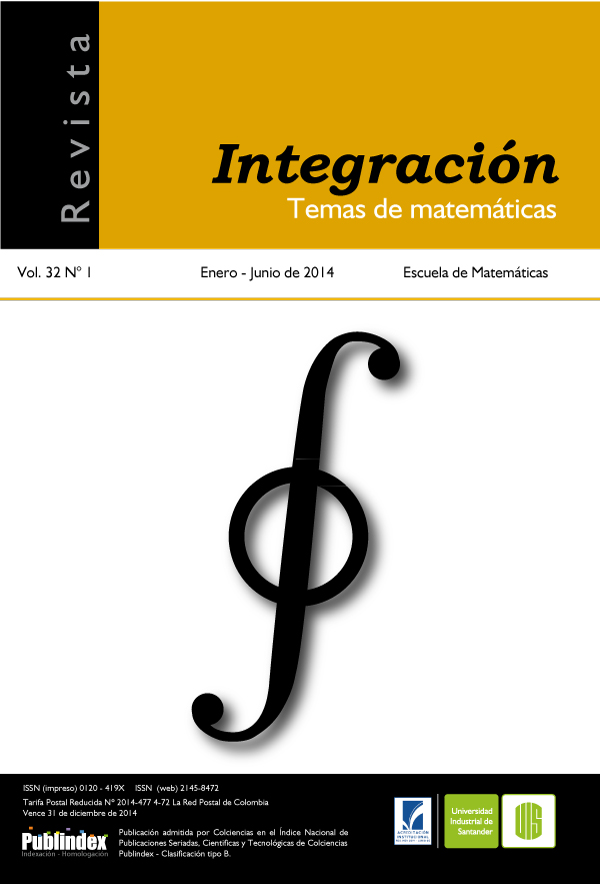Research and Innovation Articles
On bacterial resistance to bactericidal and bacteriostatic antibiotics
Published 2014-05-22
Keywords
- Equilibrium solutions,
- bacterial resistance,
- antibiotics
How to Cite
Romero L., J. P., & Ibargüen Mondragón, E. (2014). On bacterial resistance to bactericidal and bacteriostatic antibiotics. Revista Integración, Temas De matemáticas, 32(1), 101–116. Retrieved from https://revistas.uis.edu.co/index.php/revistaintegracion/article/view/4066
Abstract
In this work we formulate a simple mathematical model that describes the population dynamics of bacteria exposed simultaneously to multiple bactericidal and bacteriostatic antibiotics, assuming that resistance is acquired through mutations due to antibiotic exposure. Qualitative analysis reveals the existence of a free-bacteria equilibrium, resistant-bacteria equilibrium and an endemic equilibrium where both bacteria coexist.
To cite this article: J. Romero, E. Ibargüen, Sobre la resistencia bacteriana hacia antibióticos de acción bactericida y bacteriostática, Rev. Integr. Temas Mat. 32 (2014), no. 1, 101–116.
Downloads
Download data is not yet available.
References
- Alavez J., Avenda R., Esteva L., Fuente J., Garcia G. and Gómez G., “Withinhost population dynamics of antibiotic-resistant M. tuberculosis”, Math. Med. Biol. 24 (2006), 35–56.
- Austin D. and Anderson R., “Studies of antibiotic resistance within the patient, hospitals and the community using simple mathematical models”, Phil. Trans. R. Soc. Lond. B. 354 (1999), 721–738.
- Bonhoeffer S., Lipsitch M. and Levin B.R., “Evaluating treatment protocols to prevent antibiotic resistance”, Proc. Natl. Acad. Sci. 94 (1997), 1–106.
- Bonten M., Austin J., Daren J. and Lipsitch M., “Understanding the spread of antibiotic resistant pathogens in hospitals: mathematical models as tools for control”,Math. Med. Biol. 24 (2007), 35–56.
- Bootsma M.C.J., Van Der Horrst M.A., Guryeva T., Ter Kuile B. and Diekmann O., “Modeling non-inherited antibiotic resistance”, Bull. Math. Biol. 74 (2012), 1691–1705.
- Carvalho R.V., Kleijn J., Meijer A.H. and Verbeek F.J., “Modeling innate immune response to early mycobacterium infection”, Comput. Math. Methods Med. 12 (2012), 1–12.
- Castillo-Chávez C. and Thieme T., “Asymptotically autonomous epidemic models, mathematical population dynamics: Analysis of Heterogeneity”, Theory of Epidemics
- (1995), 33–50.
- Coll P., “Fármacos con actividad frente a mycobacterium tuberculosis”, Enferm. Infecc. Microbiol. Clin. 27 (2009), 474–480.
- D’Agata E., Magal P., Olivier D., Ruan S. and Webb G.F., “Modeling antibiotic resistance in hospitals: the impact of minimizing treatment duration”, J. Theoret.Biol. 249 (2007), 487–499.
- Dye Ch. and Espinal M.A., “Will tuberculosis become resistant to all antibiotics?”,Proc. R. Soc. Lond. B. 268 (2001), 45–52.
- Gelder L., Ponciano J.M., Abdo Z., Paul J., Larry J.F. and Eva M.T., “Combining mathematical models and statistical methods to understand and predict the dynamics of antibiotic-sensitive mutants in a population of resistant bacteria during
- experimental evolution”, Genet. 168 (2004), 1131–1144.
- Guilfoile P.G., Deadly Diseases and Epidemics: Antibiotic-Resistant Bacteria,Chelsea House Publishers, London, 2007.
- Gumbo T., Louie A., Deziel M.R., Parsons L.M., Salfinger M. and Drusano G.L.,“Selection of a moxifloxacin dose that suppresses drug resistance in Mycobacterium
- tuberculosis, by use of an in vitro pharmacodynamic infection model and mathematical modeling”, J. Infectious Diseases, 190 (2004), 1642–1651.
- Hellweger F., Ruan X. and Sánchez S., “A Simple Model of Tetracycline Antibiotic Resistance in the Aquatic Environment (with Application to the Poudre River)”, Int. J. Environ. Res. 8 (2011), 480–497.
- Ibargüen-Mondragón E. and Esteva L., “On the interactions of sensitive and resistant Mycobacterium tuberculosis to antibiotics”, Math. Biosci., 246 (2013), 84–93.
- Inggraham J., Wheelis M., Painte P. and Stanier R., Microbiología, New Jersey, Vol. II, Reverté, 1992.
- Linares J. and Martínez J., “Resistencia a los antimicrobianos y virulencia bacteriana”, Enferm. Infecc. Microbiol. Clin., 23 (2005), 86–93.
- Macheras P. and Iliadis A., Modeling in Biopharmaceutics, Pharmacokinetics, and Pharmacodynamics: Homogeneous and Heterogeneous Approaches, Springer, New York, 2006.
- Massad E., Nascimiento M. and Bezerr F., “An optimization model for antibiotic use”, Appl. Math. Comput. 201 (2008), 161–167.
- Ozcaglar C., Shabbeer A., Vandenberg S.L., Yener B., Bennett K.P., Zhang Y.,Dhandayuthapani S. and Deretic V., “Epidemiological models of Mycobacterium tuberculosis complex infections”, Math. Biosci. 236 (2012), 77–96.
- Perko L., Differential Equations and Dynamical Systems, Springer-Verla, ed 3, New York, 2000.
- Romero J., Ibargüen E. and Esteva L., “Un modelo matemático sobre bacterias sensibles y resistentes a antibióticos”, Mat. Enseñ. Univ. 20 (2011), 55–73.
- Solórzano F. and Novales G., “Resistencia a bacterias respiratorias y entéricas a antibióticos”, Revista Salud Pública, 30 (1998), 481–483.
- Sun H.R., Lu X. and Ruan S., “Qualitative analysis of models with different treatment protocols to prevent antibiotic resistance”, Math. Biosci. 227 (2010), 56–67.
- PLM-Colombia, Diccionario de Especialidades Farmacéuticas, PLM, ed 39, 2011. www.vademecum.com/co/.
- World Health Organization, The evolving threat of antimicrobial resistance. Opcions for action, WHO. 2012.
- Zhang Y., Dhandayuthapani Y. and Deretic S., “Molecular basis for the exquisite sensitivity of Mycobacterium tuberculosis to isoniazid”, Proc. Natl. Acad. Sci. 93
- (1996), 13212–13216.
